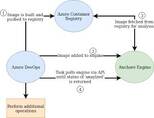DevOps through container registry

Source:-jaxenter.com
Cloud-Native and DevOps approaches are getting more and more attention in the software development world. Containerization and microservices architecture seem like the initial phase to help firms start their digital transformation. While more and more companies are embracing platforms like Docker and Kubernetes to manage the containers, images, and the other software environment dependencies, it has become challenging to handle and store the container images. To solve this issue of maintaining and organizing the container images, we have container registries.
What is a container registry?
A container registry is nothing more than a collection of container images that lets you organize and store images. This repository provides a focal location for publishing, storing, locating, downloading, and managing container images. A container registry is more than just an image repository; it contains all the versions so your consumers can effectively consume both the first version, as well as subsequent versions.
SEE ALSO: 4 steps to implement a CI/CD pipeline
You can go to Google Trends and see the steadily increasing search volume for the keyword, ‘Container Registry.’
container registry
What about DockerHub & Kubernetes?
You can use DockerHub as your container registry, but it comes with some security concerns. Like the Google Play store, it enables any ethically-challenged developer to upload malicious content, intentionally. Without some sort of moderation, check, and gatekeeper to verify and approve containers in the Docker Hub, it’s a bit of a scary scenario. It’s difficult to know whether to trust or not to trust, since it is open and unmoderated.
There is a similar security concern related to using Kubernetes. Security is the top challenge for Kubernetes users; so too, when it comes to container storage and networking.
container registry
Source Credits: TheNewStack
Need for a container registry
Container registries are here to increase developer productivity by helping them to store images created during the application development process. As we know, a container registry is a collection of container images. These images stored in the registry can be used in various phases of the software development process. Since the whole software industry is building applications using container and cloud-native technologies, to enable easier distribution of software, firms require a registry. Container registries pave the way to managing all your container images in one place and ensuring the security is as tight as possible.
A firm’s container images might contain sensitive information, and you don’t want to put them onto something like a DockerHub where they are exposed and vulnerable to attackers and major security issues. Hence, a firm’s own container registry from a 3rd-party vendor is highly recommended. It acts as an intermediary between the systems, and pushes and pulls images pertaining to a particular organization.
Since the firms are heavily dependent on producing images as a means of deploying and delivering software, the developers working on these images need hooks, plugins, and CLIs to ensure they can push into a registry from within a development environment. Container registries provide this integration for overall developer productivity and easy handling of all the container images and related activities. With a private container registry, you can implement role-based access controls, prevent vulnerabilities entering into the organization code base, add security checkpoints to secure the artifacts, etc.